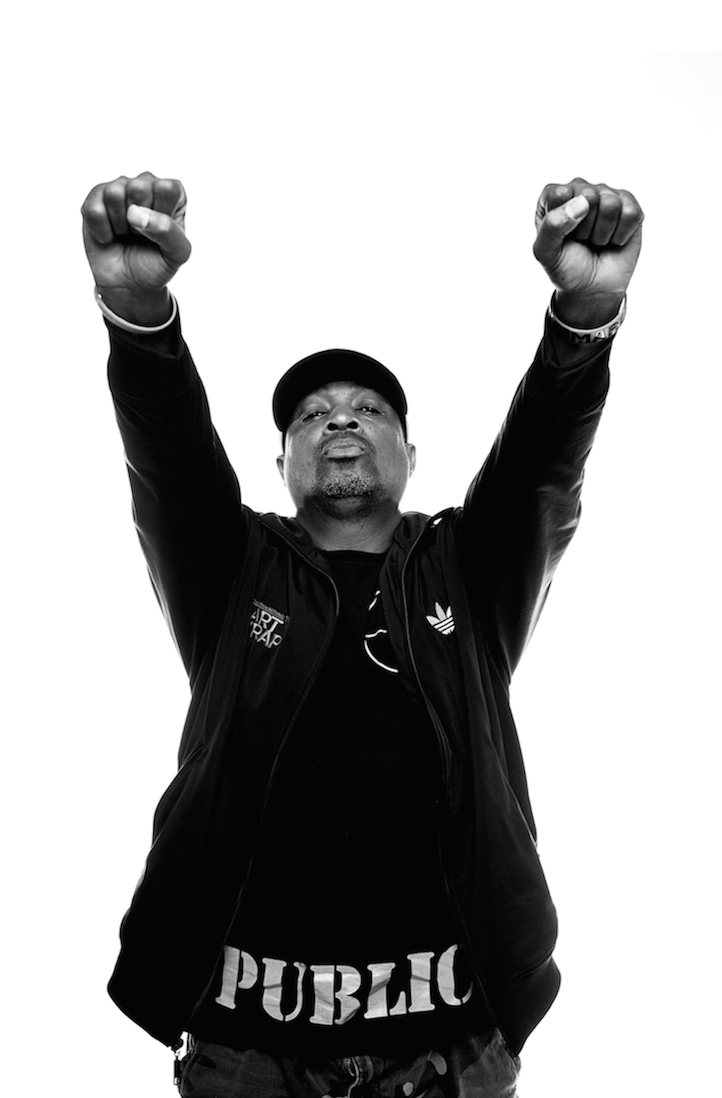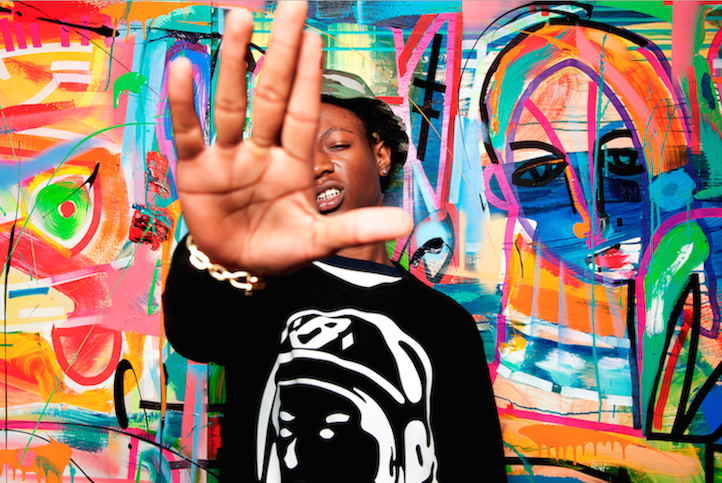Respect The Shooter: Che Kothari & “The 40 Years of Hip Hop Photography” Exhibit
05.12.2014
ART & DESIGN

Che Kothari has photographed many of hip hop’s most revered legends. His extensive catalogue of photographs featuring iconic rappers includes shots of Ice Cube, Chuck D., A Tribe Called Quest, Afrika Bambaataa, Common, Nas, and many others, so it makes sense that the Toronto-based photographer would be the brains behind an exhibition celebrating the impact of hip hop through photography.
Curated by Che and Ryan Paterson and launching at North America’s largest photography festival, Toronto’s CONTACT Photography, the 40 Years of Hip Hop Photography exhibit is set to feature 81 images from 13 of hip hop’s most respected shooters. That list includes Jonathan Mannion, Janette Beckman, Estevan Oriol, Nabil Elderkin, Jamel Shabazz, Charlie Ahearn, and of course, Che Kothari. The exhibit, which will run through May 30th, is just the beginning of what Che ultimately has planned. “My vision for 40 Years is much bigger than this exhibition in Toronto,” he admits. “I would love to see this exhibition travel throughout the world to New York, Los Angeles, Miami at Art Basel, South Africa, Tokyo, Paris, India, etc, etc.” Here, the photographer and community activist tells Life + Times how 40 Years of Hip Hop Photography came together, what it was like bringing Va$htie‘s 1992 party to Toronto and the benefits of introducing art to young people.
Life + Times: What is the 40 Years of Hip Hop exhibition about? Where did the idea for it originate?
Che Kothari: I saw some celebrations taking place last year for the 40 years of DJ Kool Herc‘s jams, but I didn’t see anything that was being done on a visual arts tip. When I spoke to the people at the CONTACT Festival I was thinking about doing a solo exhibition and releasing my first book there, but I decided that I wanted to continue to capture more personal works before releasing the book. I then had a vision to do a “Che and Friends” type of exhibition. It just happens that some of my friends and family are some of the most legendary hip hop photographers of our time. The 40 Years of Hip Hop exhibition explores the evolution of the cultural phenomenon known as hip hop through large scale photographic prints from some of the cultures’ pioneer documentarians and its contemporary image-makers. The exhibit focuses on a North American perspective and fixes its lenses on the most prominent figure from this multi-elemental culture, the emcee. The exhibit does not aim to act as a chronological or definitive recounting of the movement, but rather it aims to celebrate a collection of iconic portraits that serve as vital contributions to the immortalization of some of the legends of hip hop and the legend of hip hop itself. As it grows, I would like to host panel conversations and have mentor classes with participating photographers, so that audiences can get great context about the images they are seeing at the show. I would like to include a travelling party that goes with the event featuring DJs and music that spans the 40 years of hip hop. Why not have mixtapes that’ll also connect those years by introducing the older heads to the newer music and educating the new school kids about the foundation? I would love to see this as a coffee table print book and have all of the content that comes out of this along with the works themselves be on sale and centralized at 40yearsofhiphop.com.

L+T: What was your process like for choosing the photographers featured in the exhibit? These are some of the gods of hip hop photographers.
CK: You’re right. We have many of the gods in this exhibition and I am so humbled by that. Again, I take this role of instigator, organizer and curator with immense responsibility. I began reaching out to my inner-circle first. Jamel Shabazz and Brother Ernie Paniccioli are both mentors of mine, so I started with them and then began reaching out to the other guys I had relationships with. I co-produced Nabil Elderkin‘s video “Higher” in India last year and had screened his film Bouncing Cats at Manifesto a few years back. I have collaborated with Matt & Steve on multiple occasions. We all came up in Toronto together. I’ve exhibited works from Charlie Ahearn. I had met Mannion through a good friend of mine, Director X in Trinidad at Carnival in 2013 and maintained contact with him. I was planning on keeping it to that, but then Shabazz recommended some people and Mannion connected me to Danny Clinch. That’s when I decided to just go all the way with it and started calling artists that I wasn’t very close with. There are still more photographers that I want to bring in for this and as I said, this is still just getting started. I just added Ricky Powell and Danny Clinch to the Toronto show.
L+T: Was it a challenge getting them all together for this exhibit?
CK: Luckily, I have a great relationship based on years of love and respect with many of the photographers and as you already know, I don’t really take “no” for an answer. A lot of these photographers are still extremely active, so getting the show together did take energy as they are all busy and have such deep, deep archives, but to be honest, I have been on the road so much lately for work that I may have been the one slowing things down. Everything came together though and the exhibition is looking gorgeous. I am so grateful to all the photographers for taking time to make this vision a reality with me. Most of all, I am thankful for the trust.
L+T: At what point did you realize that photography was something that you loved?
CK: I was 15 years old and I had taken my high school’s SLR camera on a trip to an island north of Venezuela called Curacao. I attended Carnival while there. I took some incredible pictures of human spirit and celebration during that trip. That was when I realized that what I was doing was important. At that point I took photography on as not only a passion – I love it to my core – but also as a responsibility to capture stories for my generation and generations to come.
L+T: I’ve read about how you’ve had to go above and beyond to get some your shots. How important has that “go-getter” mentality been to your career?
CK: I do photography as a love and passion and not for a paycheck. It’s purpose driven for me and I see my works as a responsibility, so with that I will do whatever it takes. I bring that mentality and philosophy to everything in my life and photography is just a part of that. If I have work to do, nothing can get in my way. Any obstacle must be removed. I believe in dreaming. Everything around us was someone’s dream and by its existence it is proof that anything is possible. I walk with that mentality and never take “no” for an answer. It has proven very fruitful and has resulted in the portfolio I have today.
L+T: Through Manifesto Community Projects, you look to inspire and empower youth through arts and culture. In your opinion, what are the benefits of introducing both art and culture to young people?
CK: Art is an extremely powerful component of a holistic and healthy individual. Harvard researchers have identified eight skills that art and culture teach, which are persistence, expression, connection making, observation, envisioning, innovation through exploration, craft building and reflective self-evaluation. Many of these skills are learned exclusively through art and culture and all are essential for the leaders of tomorrow. I’ve been studying this stuff and living it [laughs]. When working with young people, my point of origin is always self and art is a great place to rigorously explore self. As you go within and better understand who you are, you start to gain a stronger sense of confidence and purpose. As you develop your toolkit of skills for self-expression, your ability to communicate your message becomes amplified. Through expression you also gain a forum for release and art can play a major role in healing and positive mental health. Art has the power to mitigate social exclusion and build economic opportunities for individuals and communities. At Manifesto we have always said art has the power to transform conflict into creativity, adversity into opportunity and oppression into expression. So many of these skills and traits that you pick up through the art making process are transferable skills that you can also carry into other aspects of your life.

L+T: Earlier this year, you helped introduce Va$htie’s 1992 party to Toronto. What was it like bringing such a legendary party to Toronto?
CK: I love hosting people, whether it be in Toronto or in any of the various home bases me and my family have around the world. Introducing and connecting people are two of my deepest passions and gifts. When I learned about Va$htie through my friend Wan Luv and my wife Mriga Kapadiya, I saw her as a kindred spirit and someone on a mission manifesting her vision through a plethora of platforms. We are both brown kids with long curly hair moving through the hip hop world. I knew she would be a great energy for people in Toronto to connect with. Toronto is a huge hip hop city and the 1992 era resonates deep with the people there. Not a lot of people knew the 1992 brand at the time, but tons of people know and love Va$htie. I lined up the event with the chekothari.com launch, so that my peoples who didn’t know her would come out to support me and learn about her and vice versa. It ended up being an epic night. The basement turned into straight bashment vibes. It was a great unification of her audience and mine. We definitely have visions of bringing the party and Va$htie back to Toronto.
L+T: What does hip hop represent for you?
CK: Hip hop is a natural mystic. It’s a vibration which resonates in our DNA and connects us to the original people. Elders and pioneers such as Brother Ernie Paniccioli, Uncle Afrika Bambaataa and KRS-One have always taught me that hip hop at its core is a sacred movement. Hip is to know and hop is to move, so at its purest, hip hop can be a knowledge movement. Hip Hop is about raw creativity, ingenuity, people power, making something out of nothing, community, love, storytelling, giving a voice to the voiceless and it has the power to transform an individual and uplift an entire community. In the wrong hands, however, it can be one of the most dangerous tools of oppression of the peoples who originally created it and can craft narratives that destroy self-love.
L+T: Throughout your career you’ve shot so many legends. Who has been your favorite to shoot?
CK: I treat every single person I shoot, whether they are a celebrity or not, with the same love, respect and reverence. Each person walks with their own energy that has been created by the layered narratives that have brought them to the moment of my capture. It is that energy that I aim to capture in that present moment. I have been blessed to shoot with the legends because so many of them walk with such powerful energy and by osmosis that energy gets transmitted to me and then I walk with it. My experiences with members of the Marley family go down in the top ranks for me though. I’ve shot Rita Marley, Damian Jr. Gong Marley, and Ziggy Marley, and each encounter was purely organic and felt guided by a higher force. I had the opportunity to photograph Rita during Bob’s earthstrong celebrations. I walked to Kingston that time with prints of a previous shoot with Ziggy. Rita chose to put those prints in the permanent collection inside the Bob Marley Museum, which is one of my greatest honors as a photographer.
L+T: What’s one thing that you’ve learned throughout the years that you wish you would’ve known when you first entered the world of photography?
CK: Over the years, I have learned more and more about my voice and my purpose in life and that has translated into my art. When I was first starting out, I would take images that were not of me, because of what a client may have wanted. Now I really take pictures that are rooted in who I am. My narrative is now intrinsically connected to the pictures I take, so the realization that I am accountable and responsible for the images I take and that I must operate with the highest level of integrity is key. I had the opportunity to investigate this to a very deep level during an artist residency program led by one of my mentors, d’bi.young called Yemoya. I spent three weeks in the mountains of India with my wife. That deep investigation of self and purpose now shines brighter in my work and it’s a continually evolving process. The images I create have the ability to last forever. I want to take great care in creating images that I want to last the test of time.
For more information on 40 Years of Hip Hop Photography, visit 40yearsofhiphop.com.





